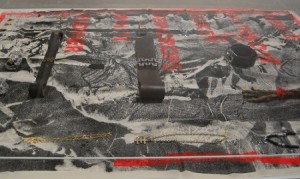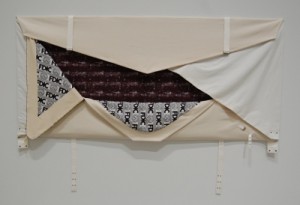Fashion has been a part of human culture for practically as long as clothing has. Surely early humans crafting tools and art objects from the ground would have turned their aesthetic judgments toward the animal skins and fabrics they donned as well. While clothing initially provided warmth and protection, it also serves as a way to express, adorn, and attract. The University of Pennsylvania’s Institute of Contemporary Art (ICA) delves headlong into the contemporary world of fashion – one that our ancestors could never have dreamed of – with its current exhibition “White Petals Surround Your Yellow Heart.”
The show, curated by Anthony Elms, is by any definition quite expansive. It fills the entire first floor gallery of ICA with the artwork of over 25 artists in mediums as diverse as fabric, prints, photography, collage, painting, and video. For a subject as vast and complicated as fashion, the amount of viewpoints and diversity of materials is necessary to the intrigue, although the sheer volume of content is at times overwhelming, especially to the fashion novice.

One way to find an entrance into the realm of wearable art is through performance. Whether posing for a photo shoot, striding down the runway, or merely seeking to impress friends, there is always an element of theater to the world of fashion. Nowhere is this clearer than in the work of the artist known mostly by the pseudonym RAMMΣLLZΣΣ. A reclusive rapper and graffiti artist who died in 2010, RAMMΣLLZΣΣ subscribed to a complex artistic theory of multiple identities which he fused together to form his persona. His Gothic Futurist style is smattered with mathematical concepts and costumes, heroes and villains. He was rarely photographed unless adorned in one his handmade outfits and his personal life was relatively private. Through his delicate curation of his artistic persona, he demonstrated – albeit in a significantly more avant-garde way – an act that most of us perform daily through our dress, social media updates, and reputation. The masks in this show are colorful and detailed, drawing on found objects, skulls, samurai helmets, and technological imagery to flesh out a unique cast of characters.

Elsewhere, another performer of sorts, Genesis Breyer P-Orridge, includes artifacts from h/er mystical artist collective “Thee Temple of Psychick Youth” as well as personal effects. Most famous for h/er role establishing the industrial music genre, P-Orridge was part of the bands COUM Transmissions, Throbbing Gristle, and Psychic TV. Until the early 90’s P-Orridge identified as a he, but along with late partner Jaye Breyer P-Orridge, both began a process of transformation to meet in the middle ground of the male/female binary genders to form a “Third Being” or Pandrogyne. Here, fashion and accessories become a way to bend and alter the social norms and sexual mores of our day. To stop at attire would neglect other notable facets of physical appearance, however. As part of their Pandrogynous experiments, the pair also engaged in cosmetic changes and plastic surgery, forever altering their bodies and ultimately their gender identities as well. One piece included in the show is a vial of Chanel No. 5 perfume mixed with blood, which is perhaps a criticism of Coco Chanel’s questionable dealings with the Nazi regime. This “Blood Sacrifice” also references P-Orridge’s bodily changes, as well as the processes of growth and mortality that we all face. The idea of suffering for fashion here is quite tangible.

A series of fabric pieces by Seth Price seem to focus appropriately on the costs and economic baggage that accompany clothing and the fashion industry. One large sleeping-bag-like form more precisely resembles a gigantic envelope, complete with an interior obfuscating pattern for privacy (in this case, the repeated logo of the FDIC). The organization which provides financial insurance is here part of a snug, safe-looking sheath which eerily also calls to mind the restraint of a straightjacket. After an economic crisis from which many of us are still reeling (and lacking expendable income), the duties of fiscal watchdog and consumer-protection groups certainly rides the line between imaginary comfort and less-than-useful, red-tape regulation. On a nearby clothing rack, Price displays a line of various military jackets. Their exterior, like the “Patchwork Style Bag” is a muted shade of white, and their linings depict the logos of such institutions as UBS and Paychex. At a time when many tout the benefits of austerity measures to reign in debt, military spending is notably absent from most budget cuts. While there is clearly a culture of luxury and waste that accompanies the often over-the-top world of high fashion, these works prove that it certainly exists elsewhere in society as well.

Erin Leland turns the entire relationship of shopping inside out by posing in store windows as a mannequin, camera in hand. Window shoppers idly strolling and half-consciously examining the wares of various stores are taken aback as the apparently lifeless display betrays its existence as not a model, but an artist. This precious moment of realization is when Leland snaps a candid photo, revealing the tenuous ground between looking and being looked at. The consumers’ experience with the objects of their desire is intimate indeed, even before any money is exchanged. Whether an actual paying customer, a pipe-dreamer with a drained savings, or merely a passerby with a curious eye, Leland manages to capture the unique and often unseen perspective of the shopper as they are similarly snared in the web of the advertiser and designer.

This analysis of “White Petals Surround Your Yellow Heart” barely manages to scratch the surface of a vast exhibition. With a glut of artists and artwork piecing together the puzzle of fashion and contemporary style from as many vantage points, it is necessary to focus on only a few. While the designers and models of New York or Paris seem to have little in common with those of us in the jeans and t-shirt crowd, every one of us makes decisions daily concerning our appearance and the aesthetics of our wear. Our external self may only be one layer of our being but it is probably the only one that is universally visible.
Read Andrea Kirsh’s review of this show.





